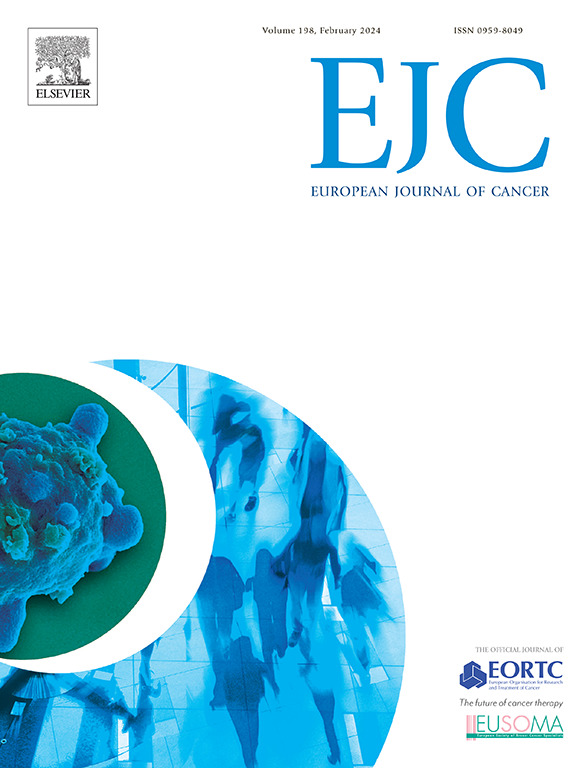Radiation vs. trans-oral surgery for treatment de-escalation in HPV-related oropharyngeal cancers: Primary analysis of the ORATOR2 randomized trial
IF 7.6
1区 医学
Q1 ONCOLOGY
引用次数: 0
Abstract
Background
The optimal treatment de-escalation approach for HPV-related oropharyngeal squamous cell carcinomas (OPSCC) is unknown. The objective was to assess two de-escalation approaches: primary radiotherapy (RT) vs. transoral surgical (TOS).
Patients and methods
Patients with T1-T2 N0–2 HPV-related OPSCC were randomly assigned to primary RT (60 Gy with concurrent weekly cisplatin in node-positive) vs. TOS + neck dissection (ND) (and adjuvant reduced-dose RT depending on pathology). The primary endpoint was 2-year OS (hypothesized to be 94 % in each arm, compared to 84 %). Secondary endpoints included comparisons of survival and quality of life between arms. The trial was stopped early due to two treatment related deaths in the surgical arm.
Results
Sixty-one patients were randomized (n = 30 in RT arm and n = 31 in TOS+ND arm), with a median age of 62 years (IQR: 57–68). The majority were male (n = 51) and never-smokers (n = 31). Median follow-up was 3.7 years (IQR: 3.1–4.5 years). In the RT arm, the primary endpoint for acceptability was met (p = 0.008), and two-year OS was 100 % (95 % confidence interval [CI]: 100–100 %). In the TOS+ND arm, the primary endpoint was not met (p = 0.296) and two-year OS was 90 % (95 % CI: 71–97 %), significantly worse than the RT arm (p = 0.041). Two-year progression-free survival (PFS) were 100 % (95 % CI: 100–100 %) vs. 86 % (95 % CI: 67–95 %) respectively (p = 0.012). Mean (± SD) 2-year MDADI total scores were 89 ± 13 vs. 83 ± 11, respectively (p = 0.11), and grade 2–5 toxicity rates were similar (n = 21 vs. n = 24 respectively, p = 0.51), with no additional grade 5 events.
Conclusion
For treatment de-escalation, a primary RT approach achieved excellent oncologic and functional outcomes and should be tested in phase III de-escalation trials.
Trial Registration
Clinicaltrials.gov NCT03210103.
放疗与经口手术治疗hpv相关口咽癌缓解:ORATOR2随机试验的初步分析
hpv相关口咽鳞状细胞癌(OPSCC)的最佳治疗降压方法尚不清楚。目的是评估两种降压方法:原发性放疗(RT)与经口手术(TOS)。患者和方法T1-T2 N0-2 hpv相关OPSCC患者被随机分配到原发性放疗(60 Gy,淋巴结阳性患者每周顺铂治疗)和TOS + 颈部清扫(ND)(以及根据病理情况辅助减少剂量的放疗)。主要终点为2年OS(假设每组94% %,对比84% %)。次要终点包括两组间生存和生活质量的比较。由于手术组有两例与治疗相关的死亡,该试验被提前终止。结果随机纳入61例患者(RT组n = 30例,TOS+ND组n = 31例),中位年龄62岁(IQR: 57 ~ 68)。大多数是男性(n = 51)和从不吸烟(n = 31)。中位随访时间为3.7年(IQR: 3.1-4.5年)。在RT组中,达到了可接受性的主要终点(p = 0.008),两年OS为100% %(95 %置信区间[CI]: 100 - 100 %)。在TOS+ND组中,主要终点未达到(p = 0.296),两年OS为90 %(95 % CI: 71-97 %),显著低于RT组(p = 0.041)。两年无进展生存期(PFS)分别为100 %(95 % CI: 100 - 100 %)和86 %(95 % CI: 67-95 %)(p = 0.012)。意味着(± SD) 2年MDADI总分89 ± 13和83 ± 11日分别为(0.11 p = ),和2 - 5级毒性率相似(n = 21与n = 24分别p = 0.51),没有额外的五年级的事件。结论:对于降压治疗,初级RT方法获得了良好的肿瘤学和功能结果,应该在III期降压试验中进行测试。临床试验注册。gov NCT03210103。
本文章由计算机程序翻译,如有差异,请以英文原文为准。
求助全文
约1分钟内获得全文
求助全文
来源期刊

European Journal of Cancer
医学-肿瘤学
CiteScore
11.50
自引率
4.80%
发文量
953
审稿时长
23 days
期刊介绍:
The European Journal of Cancer (EJC) serves as a comprehensive platform integrating preclinical, digital, translational, and clinical research across the spectrum of cancer. From epidemiology, carcinogenesis, and biology to groundbreaking innovations in cancer treatment and patient care, the journal covers a wide array of topics. We publish original research, reviews, previews, editorial comments, and correspondence, fostering dialogue and advancement in the fight against cancer. Join us in our mission to drive progress and improve outcomes in cancer research and patient care.
 求助内容:
求助内容: 应助结果提醒方式:
应助结果提醒方式:


